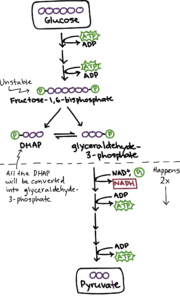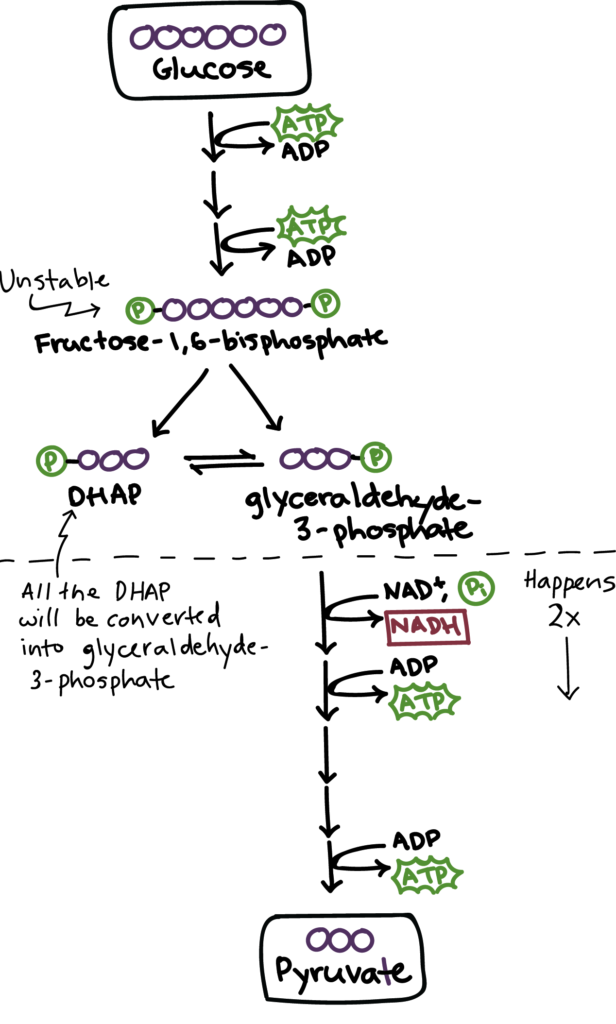Glycolysis
Glycolysis is the first step in the breakdown of glucose to extract energy for cellular metabolism. Glycolysis consists of an energy-requiring phase followed by an energy-releasing phase.
VOCABULARY: GLYCOLYSIS, BREAKDOWN, EXTRACT,PHASE, CONSISTS OF
Introduction
Suppose that we gave one molecule of glucose to you and one molecule of glucose to Lactobacillus acidophilus—the friendly bacterium that turns milk into yogurt. What would you and the bacterium do with your respective glucose molecules?
VOCABULARY: SUPPOSE, GLUCOSE, RESPECTIVE
Overall, the metabolism of glucose in one of your cells would be pretty different from its metabolism in Lactobacillus—check out the fermentation article for more details. Yet, the first steps would be the same in both cases: both you and the bacterium would need to split the glucose molecule in two by putting it through glycolysisstart superscript, 1, end superscript.
What is glycolysis?
Glycolysis is a series of reactions that extract energy from glucose by splitting it into two three-carbon molecules called pyruvates. Glycolysis is an ancient metabolic pathway, meaning that it evolved long ago, and it is found in the great majority of organisms alive today.
In organisms that perform cellular respiration, glycolysis is the first stage of this process. However, glycolysis doesn’t require oxygen, and many anaerobic organisms—organisms that do not use oxygen—also have this pathway.
VOCABULARY: REACTIONS, SPLITTING, PATHWAY, EVOLVED, RESPIRATION,

Highlights of glycolysis
Glycolysis has ten steps, and depending on your interests—and the classes you’re taking—you may want to know the details of all of them. However, you may also be looking for a greatest hits version of glycolysis, something that highlights the key steps and principles without tracing the fate of every single atom. Let’s start with a simplified version of the pathway that does just that.
VOCABULARY: HIGHLIGHTS, KEY STEPS, TRACING
Glycolysis takes place in the cytosol of a cell, and it can be broken down into two main phases: the energy-requiring phase, above the dotted line in the image below, and the energy-releasing phase, below the dotted line.
- Energy-requiring phase. In this phase, the starting molecule of glucose gets rearranged, and two phosphate groups are attached to it. The phosphate groups make the modified sugar—now called fructose-1,6-bisphosphate—unstable, allowing it to split in half and form two phosphate-bearing three-carbon sugars. Because the phosphates used in these steps come from start text, A, T, P, end text, two start text, A, T, P, end text molecules get used up.
VOCABULARY: DOTTED LINE, ENERGY RELEASING, REARRANGED, UNSTABLE, PHOSPHATE-BEARING
The three-carbon sugars formed when the unstable sugar breaks down are different from each other. Only one—glyceraldehyde-3-phosphate—can enter the following step. However, the unfavorable sugar, start text, D, H, A, P, end text, can be easily converted into the favorable one, so both finish the pathway in the end
- Energy-releasing phase. In this phase, each three-carbon sugar is converted into another three-carbon molecule, pyruvate, through a series of reactions. In these reactions, two start text, A, T, P, end text molecules and one start text, N, A, D, H, end text molecule are made. Because this phase takes place twice, once for each of the two three-carbon sugars, it makes four start text, A, T, P, end text and two start text, N, A, D, H, end text overall.
VOCABULARY: UNSTABLE, UNFAVORABLE, CONVERTED
Each reaction in glycolysis is catalyzed by its own enzyme. The most important enzyme for regulation of glycolysis is phosphofructokinase, which catalyzes formation of the unstable, two-phosphate sugar molecule, fructose-1,6-bisphosphatestart superscript, 4, end superscript. Phosphofructokinase speeds up or slows down glycolysis in response to the energy needs of the cell.
Overall, glycolysis converts one six-carbon molecule of glucose into two three-carbon molecules of pyruvate. The net products of this process are two molecules of start text, A, T, P, end text (4 start text, A, T, P, end text produced minus 2 start text, A, T, P, end text used up) and two molecules of start text, N, A, D, H, end text.
VOCABULARY: CATALYSED, ENZYME, FORMATION
Detailed steps: Energy-requiring phase
We’ve already seen what happens on a broad level during the energy-requiring phase of glycolysis. Two start text, A, T, P, end texts are spent to form an unstable sugar with two phosphate groups, which then splits to form two three-carbon molecules that are isomers of each other.
Next, we’ll look at the individual steps in greater detail. Each step is catalyzed by its own specific enzyme, whose name is indicated below the reaction arrow in the diagram below.
VOCABULARY: BROAD LEVEL, UNSTABLE, SPLITS
QUESTIONS:
- WHAT PERCENTAGE OF CARBOHYDRATES DOES YOUR DIET CONSIST OF?
- WHAT PERCENTAGE OF PRONIENS, FATS AND CARBS SHOULD A HEALTHY DIET CONSIST OF?
- WHAT COMMON FOODS DO WE EAT TO GET CARBOHYDRATES
TO CONTINUE LEARNING FOLLOW THIS WEBSITE:

